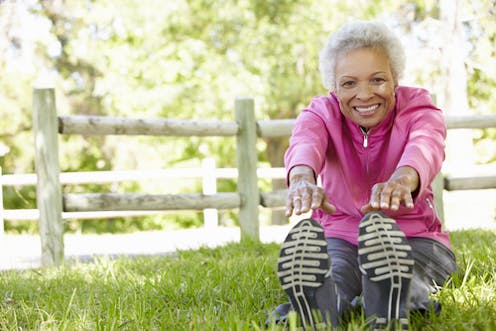To feel happier, we have to resolve to the life we evolved to live
As the new year gets underway, millions will make resolutions. The author explains why resolving to live in accordance with the way humans have evolved could go a long way to increasing happiness.

When we have to give a talk to a group of people, we feel anxious and experience the bodily fear responses that do not make sense now: The system is not meant to function in this safe context.
As a psychiatrist specialized in anxiety and trauma, I often tell my patients and students that to understand how fear works in us, we have to see it in the context where it evolved. Ten thousand years ago, if another human frowned at us, chances were high one of us would be dead in a couple minutes. In the tribal life of our ancestors, if other tribe members did not like you, you would be dead, or exiled and dead.
Biological evolution is very slow, but civilization, culture, society and technology evolve relatively fast. It takes around a million years for evolutionary change to happen in a species, and people have been around for about 200,000 years. Each of us, however, sees drastic changes in our lifestyle and environment over a matter of a few years.
Let’s compare the life for which this body and brain has evolved with the life we live, from my perspective as a scientist and a physician.
What we eat
We evolved in a context of scarcity, and had to walk or run for miles and scavenge to find food; we had to work for it. When we ate, we did not know when the next time would be. When we had it, we were better off eating the high-calorie food that increased our chance of survival when hungry (greasy food feels appealing). Food was not quick to digest, stomachs also had to work hard for it: meat, fruits, vegetables, seeds and nuts. None of these contained “easy” sugary calories. The body that was prone to starvation, evolved to eat it all when available, and store it, and be stingy in its use.
But now, food is just a few feet away, and we can easily consume thousands of calories in one serving. Fatty food, which required days and miles of hunting and scavenging to acquire, is now right there in the fridge or at the McDonald’s. It is like giving full fridge privileges to your Labrador. Easy calories like soda and candies provide a very large amount of energy in a very short amount of time and confuse the whole system. We end up fat and fatigued.
How we move

Our ancestors had to be active to survive in the wild. They had to walk miles a day, and were frequently involved in high intensity physical activity: moving heavy objects, climbing, fighting, chasing a prey or fleeing predators.
This body did not evolve to sit at a desk eight hours a day, and then lie on a couch for the rest of the day munching on high calorie food, looking at a small or large screen. A contemporary American may only walk a few dozen steps to the car, drive to work, ride the elevator to the office, walk a few dozen steps back to the car, get drive-thru food, then be back on the couch. Suboptimal muscles use leads to weaker joint support, and weird postures cause pain. Pain leads to reduced activity, more obesity and weaker muscles; then comes opioid epidemic, overuse of pain medications, and back surgeries for all!
How we sleep
Before TVs, halogen lamps, and video games, our sleep was regulated by diurnal change in exposure to the big lamp in the sky and environment temperature. Light and sounds got dimmed, the body and brain had time to slow down and get ready for sleep.
Well now, we go 60 miles per hour with TV and music and video games and intense stimulation by the social media (switching through hundreds of subjects in a matter of minutes), and then hope for a good night sleep – that ain’t happening. Quick 60 to 0 is not how our brains are wired.
How we fear
Back when we had regular exposure to fear, fear was a normal part of life. Predators were always ready to munch on us, and other tribes or our tribe mates were ready to take over our food or stone hammer. The fear circuitry got regularly stimulated. Paired with regular intense physical activity, the adrenergic system, which increased activity causes fight-flight responses, would get a good share of workout.
Our current life is usually too safe, and we feel anxious and terrified about things which may be important but really do not threaten our life or integrity, such as a work meeting, going to a party or an exam. I do not have solid scientific evidence for this claim, so please take it with a grain of salt: I think some of our anxieties may be due to absence of a normal exposure to real danger. The same way our bodies need the regular exercise, our brains and bodies may also need a regular normal dose of real fear. That may be one reason for our love of horror and mystery movies, games, haunted houses and other controlled fear experiences.
What can we do to feel better?

When we adopt a pet, we learn about their normal environment, activity level and nutrition. Isn’t it interesting that we do not apply that to the animal we live in? To feel normal, we should live normal, and a human’s normal life is that for which she or he has evolved.
So I believe the first step is to understand ourselves, and why we do what we do, and desire what we desire. When we crave fatty food, or cannot stop eating, that is because the human animal had to do so to survive. Such understanding brings empathy, reduces judgment and helps us get creative.
Keep away the high-calorie sugary food. I tell my patients: do not buy it, or if you do, buy in small amounts. Try to eat what you were evolved to eat. Know the body is lazy, because it wants to save precious energy. The drag of going to the gym may be because of that. Also know that this body would be much happier when it is regularly, and highly active. We know that exercise is not only helpful for cardiovascular and bodily health, but also reduces anxiety.
I ask all my patients to commit to some level of exercise, as part of their treatment plan. And it does not have to be treadmill or gym. Whatever rocks your boat: yoga, boxing, walking, running up the stairs at work, doing 20 push-ups, 20 sit-ups and 20 squats a day, or dancing to a TV ad; whatever make your heart pound faster. Other bonuses come with exercise: getting sun exposure or to know your neighbor when walking the dog, making new friends (or a date) at the gym, feeling better about yourself, and being more attractive to yourself and others. All these factors lift your mood. Do not feel disappointed if you did not lose weight, it’s not the only goal. Other benefits are abundant and even more important: increased strength and energy, cardiovascular and joint health, improved mood, etc.
When it comes to sleep, changing behavior works. Here are some tips for better sleep: avoid late caffeine, bright screens (including your phone – Facebook can wait), and use your bed only for sleep and sex.
Finally, you may need a regular dose of healthy and safe exposure to real-life excitement, and a little bit of fear.
Bottom line: If we treated our body the way responsible dog owners treated their dog, we would live a much happier life.
Arash Javanbakht does not work for, consult, own shares in or receive funding from any company or organization that would benefit from this article, and has disclosed no relevant affiliations beyond their academic appointment.
Read These Next
Congress takes up health care again − and impatient voters shouldn’t hold their breath for a cure
Why does health care reform keep failing despite decades of attention and expanding costs? A scholar…
How facial recognition for bears can help ecologists manage wildlife
Recent advances in computer vision and other types of artificial intelligence offer an opportunity for…
Wearing a weighted vest can promote bone health and weight loss, but it’s not a cure-all
Are weighted vests more than a fitness fad? A health and exercise expert explains their potential benefits…






